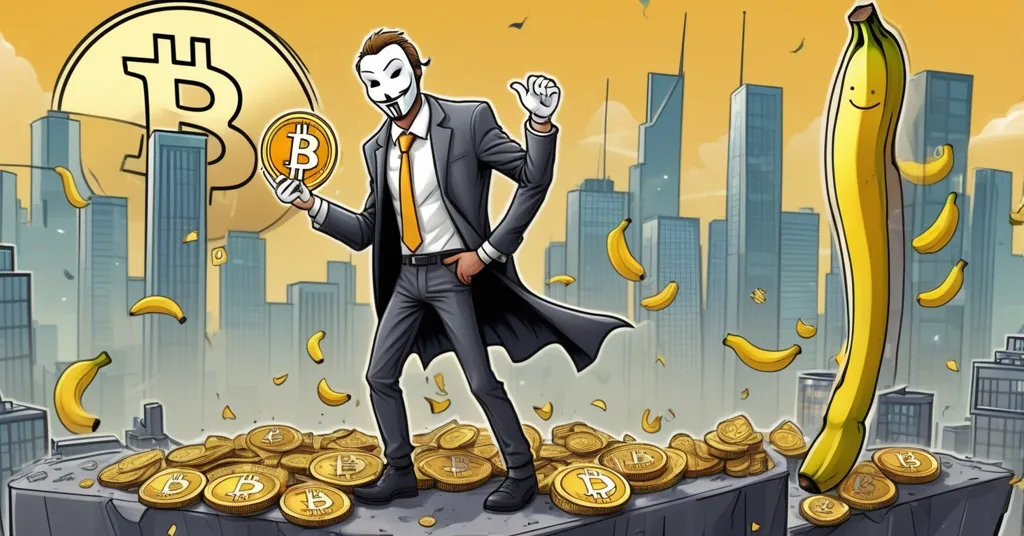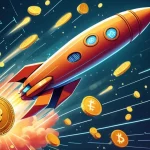Robert Kiyosaki Bets on Bitcoin at $110K, Targets $1M by 2030 Amid Bubble Warnings

Robert Kiyosaki’s Bitcoin Gamble: Bullish at $110K, Betting on Dips Amid Wild Predictions
Robert Kiyosaki, the financial heavyweight and author of Rich Dad Poor Dad, has doubled down on Bitcoin, snapping up more at $110,000 while eyeing future dips to stack his holdings. With Bitcoin recently touching a high of $110,300, his mix of bold price targets—$250,000 by 2025 and a staggering $1 million by 2030—and stark warnings about market mania paint a vivid picture of crypto’s current frenzy: revolutionary promise tangled with ruthless risk.
- Latest Play: Kiyosaki bought Bitcoin at $110K after an early entry at $6K, ready to buy more if prices crash.
- Big Targets: Predicts $250K by 2025, with a long-term moonshot of $1M by 2030.
- Red Flag: Cautions about the “Banana Zone,” a FOMO-driven surge that often ends in sharp, painful drops.
Kiyosaki’s Bitcoin Playbook: From $6K to $110K and Beyond
Kiyosaki isn’t new to the Bitcoin game. He first jumped in at $6,000, a steal compared to today’s nosebleed levels, showing a knack for spotting value long before the mainstream caught on. His recent purchase at $110,000, just shy of the current peak of $110,300, signals unshakable confidence in Bitcoin as a cornerstone asset, as detailed in his latest move to buy Bitcoin at $110K and plan for more on dips. Why? He sees it as “digital gold”—a decentralized shield against the erosion of fiat currencies, which he argues are being devalued by runaway inflation and ballooning government debt. With Bitcoin’s supply capped at 21 million coins, it’s a scarce asset in a world where central banks print money like it’s going out of style.
But before you rush to buy, let’s unpack Kiyosaki’s broader philosophy. Famous for preaching financial independence in Rich Dad Poor Dad, he’s long favored assets like real estate and gold that dodge government overreach. Bitcoin fits this mold perfectly—a currency unbound by bureaucrats, secured by a blockchain, which is essentially a public ledger maintained by a global network of computers, not politicians. Yet, unlike gold or property, Bitcoin’s wild price swings test even the steeliest of nerves. Kiyosaki’s history of buying low and holding through chaos, as explored in his investment strategies, suggests he’s not just a cheerleader; he’s a calculated player betting on long-term disruption over short-term hype.
The Banana Zone: A Hype Trap Waiting to Snap
Here’s where Kiyosaki throws a bucket of cold water on the party. He’s sounding the alarm on what financial analyst Raoul Pal calls the “Banana Zone”—think of it as a market bubble on steroids, where fear of missing out (FOMO) sends prices soaring as retail investors, media hype, and big institutions pile in. It looks like a golden ticket, but it’s often a setup for a brutal crash, a concept further explained in this Banana Zone breakdown. Bitcoin’s history backs this up: in 2017, it rocketed to $20,000 only to plummet 84% to $3,200 by 2018. In 2021, a high of $69,000 cratered to $16,000 by late 2022. Volatility isn’t just a risk; it’s baked into the beast.
“I am a fat PIG with Bitcoin,”
Kiyosaki declared, framing himself as a disciplined accumulator who sidesteps emotional traps. His blunt advice? Don’t buy into the euphoria. Chasing peaks in this Banana Zone can leave you holding the bag when sentiment flips. He’s even hoping for a crash—not out of pessimism, but to snag more Bitcoin at bargain prices while others panic-sell. It’s a gut-punch contrarian take that cuts through the endless “$500K tomorrow” garbage clogging social media. We’re not buying that trash, and neither should you, especially when community discussions like those on Reddit about Kiyosaki’s Bitcoin views often highlight skepticism.
“The ‘Banana Zone’ might look like a golden opportunity, but it’s also a dangerous trap for the unprepared,”
he warned, pushing education and patience over reckless greed. For newcomers, FOMO is that itch to jump in at all-time highs, often right before a drop. Kiyosaki’s urging a cooler head—understand Bitcoin’s cycles, know its risks, and don’t bet the farm on a tweet from some self-proclaimed guru.
Bitcoin’s Rally: Institutional Fuel and Macro Winds
Zooming out, Kiyosaki’s optimism isn’t pulled from thin air. Bitcoin’s surge to $110,300 isn’t just retail madness; institutional money is pouring in. Spot Bitcoin ETFs—investment funds that track Bitcoin’s price and trade on traditional exchanges—saw inflows of $769.6 million in a single week recently. Companies like Metaplanet (holding over 15,000 BTC) and Blockchain Group (nearly 2,000 BTC) are stashing it in their treasuries as a hedge against economic uncertainty. This isn’t pocket change; it’s a seismic shift signaling Bitcoin as a legitimate store of value in corporate eyes.
Then there’s the macroeconomic angle. Distrust in fiat currency—government-issued money like the U.S. dollar, backed by nothing but faith—is at a fever pitch with inflation gnawing at savings and national debts spiraling. Bitcoin, untethered from central bank meddling, offers an escape hatch. Add potential U.S. Federal Reserve moves, like cutting interest rates, and the setup gets juicier. Lower rates make safe investments like bonds less appealing, often pushing capital into riskier plays like crypto, a trend analyzed in this Federal Reserve impact study. As Dan Raju, CEO of Tradier, noted, rate cuts are a green light for the Bitcoin crowd, historically sparking rallies.
But don’t get too cozy. Headwinds loom large. Bitcoin’s technicals show it teetering near a key support level of $108,482, with resistance at $109,267. A break below could trigger a slide; a break above might ignite the next leg up. Beyond charts, geopolitical risks—like renewed U.S. tariffs or tensions with China—could spook markets, tanking risk assets across the board. Economic slowdown fears aren’t helping either. And let’s not ignore regulation: the SEC’s ongoing scrutiny and global frameworks like the EU’s MiCA could clamp down on crypto’s freewheeling nature overnight. Kiyosaki’s bullishness might have legs, but it’s walking a tightrope.
The Million-Dollar Question: Can Bitcoin Hit $1M by 2030?
Kiyosaki’s price targets—$250,000 by 2025 and $1 million by 2030—are the kind of numbers that make even hardened HODLers blink. Are they grounded or just wild dreams? On the bullish side, if institutional adoption keeps accelerating and fiat trust keeps crumbling, five- or six-figure valuations aren’t fantasy, a perspective echoed in forecasts like those in Kiyosaki’s Bitcoin predictions for 2025 and 2030. Bitcoin’s halving events—where mining rewards are cut in half every four years, shrinking new supply—have historically juiced prices. The next one in 2028 could align with Kiyosaki’s timeline for a major leap.
Now, let’s play devil’s advocate. A $1 million Bitcoin implies a market cap of $21 trillion, dwarfing gold’s current $16 trillion and rivaling entire stock indices. That’s a tall order when you factor in competition from altcoins like Ethereum, which dominates smart contracts—programmable agreements on a blockchain that power everything from DeFi to NFTs—areas Bitcoin doesn’t touch. Regulatory roadblocks could also derail the train; imagine a U.S. election swinging toward crypto-hostile policies or China doubling down on bans. Past cycles show post-hype crashes wipe out gains in months, not years. Kiyosaki’s long-term vision is enticing, but it’s a gamble ignoring some ugly realities, as questioned by many in platforms like Quora discussions on his Bitcoin forecasts.
Bitcoin’s Tech Edge: Beyond Price Hype
While price chatter dominates, innovation in Bitcoin’s ecosystem keeps chugging. Take Bitcoin Hyper ($HYPER), a Layer 2 solution built on Solana that’s raised nearly $2 million in presale. For the uninitiated, Layer 2s are secondary networks that handle transactions off Bitcoin’s main chain to boost speed and cut costs, while still leveraging its security. Bitcoin’s core blockchain processes just a handful of transactions per second—compare that to Visa’s thousands—leading to delays and high fees during peak demand. Solutions like these aim to fix that, potentially widening Bitcoin’s use case beyond “digital gold” to everyday payments. It’s a reminder: Bitcoin’s value isn’t just speculative; it’s a tech play too, even if Kiyosaki’s focus stays on price.
Still, these developments are sideshows to the main drama—can Bitcoin sustain this rally without eating itself in hype? Scalability fixes won’t shield it from a Banana Zone bust, and regulatory whiplash could stall adoption no matter how slick the tech gets. It’s a double-edged sword: innovation fuels optimism, but the market’s mood swings don’t care about code.
Kiyosaki’s Crash Hunger: Smart or Anti-Adoption?
Let’s chew on Kiyosaki’s crash-hungry stance. Hoping for a dip to buy cheap isn’t just contrarian—it’s a middle finger to the “Bitcoin only goes up” crowd. But is it wise? On one hand, it’s vintage Kiyosaki: buy low, sell high, or don’t sell at all. Historical dips—like the 2022 low of $16,000—proved golden for patient buyers. On the other, rooting for volatility might undercut Bitcoin’s narrative as a stable store of value. Some Bitcoin maximalists argue this “buy the dip” obsession keeps the market jittery, scaring off normies who crave predictability. Is Kiyosaki playing chess while others flip coins, or is he just gambling with extra steps? It’s a question worth wrestling with as adoption battles perception, especially when considering the accuracy of his past calls in this analysis of Kiyosaki’s Bitcoin predictions.
Key Takeaways and Bitcoin Questions Answered
- What is the “Banana Zone” driving Bitcoin’s current surge?
Coined by Raoul Pal, it’s a phase of explosive price growth fueled by FOMO, media buzz, and institutional buying, often followed by steep corrections as euphoria flips to panic. - Why is Robert Kiyosaki so bullish on Bitcoin as an investment?
He sees it as “digital gold,” a decentralized hedge against inflation and fiat currency collapse, with its fixed 21 million coin supply protecting wealth from government overprinting. - What risks does Kiyosaki highlight in this Bitcoin rally?
He warns against emotional buying in the Banana Zone, where hype can lead to devastating losses during crashes, urging discipline and education over chasing peaks. - How could Federal Reserve policies sway Bitcoin’s price?
Cutting interest rates could drive capital into risk assets like Bitcoin by making traditional investments less attractive, a pattern seen in past crypto rallies. - Is Kiyosaki’s crash-hoping strategy a genius move or a risky bet?
It’s a savvy contrarian play to buy low after panic selling, but it risks misreading market sentiment if no dip comes or if broader adoption stumbles. - Should beginners buy Bitcoin near all-time highs like $110K?
Proceed with caution—historical cycles show highs often precede sharp drops; start small, use secure wallets, and avoid FOMO-driven decisions as Kiyosaki advises. - Why is Bitcoin so volatile compared to traditional assets?
Its relatively small market, speculative nature, and sensitivity to news—regulation, hacks, or macro shifts—create wild swings, unlike stabilized assets like stocks or gold.
Bitcoin’s roaring run is a high-stakes rollercoaster, blending revolutionary potential with the kind of volatility that can turn millionaires into bagholders overnight. Kiyosaki’s blend of bullish conviction and hard-edged caution mirrors the crypto space itself: a middle finger to failing systems, yet a minefield for the clueless. Institutional money and macro shifts might propel it to dizzying heights, but history screams that every Banana Zone has a bitter end. Whether you’re a seasoned HODLer or a curious newbie, the takeaway is brutal but simple—know your strategy, keep your head, and don’t fall for the hype. If Kiyosaki’s playing chess, make sure you’re not just rolling dice. Keep some dry powder handy; a dip might be your move, or your trap.



